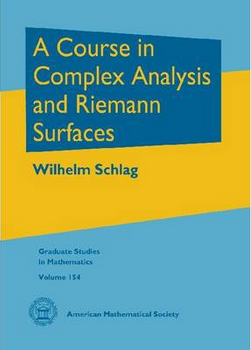
A Course in Complex Analysis and Riemann Surfaces
[BOOK DESCRIPTION]
Complex analysis is a cornerstone of mathematics, making it an essential element of any area of study in graduate mathematics. Schlag's treatment of the subject emphasizes the intuitive geometric underpinnings of elementary complex analysis that naturally lead to the theory of Riemann surfaces. The book begins with an exposition of the basic theory of holomorphic functions of one complex variable. The first two chapters constitute a fairly rapid, but comprehensive course in complex analysis. The third chapter is devoted to the study of harmonic functions on the disk and the half-plane, with an emphasis on the Dirichlet problem. Starting with the fourth chapter, the theory of Riemann surfaces is developed in some detail and with complete rigor. From the beginning, the geometric aspects are emphasized and classical topics such as elliptic functions and elliptic integrals are presented as illustrations of the abstract theory. The special role of compact Riemann surfaces is explained, and their connection with algebraic equations is established.The book concludes with three chapters devoted to three major results: the Hodge decomposition theorem, the Riemann-Roch theorem, and the uniformization theorem. These chapters present the core technical apparatus of Riemann surface theory at this level. This text is intended as a fairly detailed, yet fast-paced intermediate introduction to those parts of the theory of one complex variable that seem most useful in other areas of mathematics, including geometric group theory, dynamics, algebraic geometry, number theory, and functional analysis. More than seventy figures serve to illustrate concepts and ideas, and the many problems at the end of each chapter give the reader ample opportunity for practice and independent study.
[TABLE OF CONTENTS]
Preface vii
Acknowledgments xv
Chapter 1 From i to z: the basics of 1 (40)
complex analysis
§1.1 The field of complex numbers 1 (3)
§1.2 Holomorphic, analytic, and 4 (5)
confermal
§1.3 The Riemann sphere 9 (2)
§1.4 Mobius transformations 11 (4)
§1.5 The hyperbolic plane and the 15 (3)
Poincare disk
§1.6 Complex integration, Cauchy 18 (5)
theorems
§1.7 Applications of Cauchy's 23 (10)
theorems
§1.8 Harmonic functions 33 (3)
§1.9 Problems 36 (5)
Chapter 2 From z to the Riemann mapping 41 (44)
theorem: some finer points of basic complex
analysis
§2.1 The winding number 41 (4)
§2.2 The global form of Cauchy's 45 (2)
theorem
§2.3 Isolated singularities and 47 (9)
residues
§2.4 Analytic continuation 56 (4)
§2.5 Convergence and normal families 60 (3)
§2.6 The Mittag-Leffler and 63 (6)
Weierstrass theorems
§2.7 The Riemann mapping theorem 69 (5)
§2.8 Runge's theorem and simple 74 (5)
connectivity
§2.9 Problems 79 (6)
Chapter 3 Harmonic functions 85 (44)
§3.1 The Poisson kernel 85 (6)
§3.2 The Poisson kernel from the 91 (4)
probabilistic point of view
§3.3 Hardy classes of harmonic 95 (5)
functions
§3.4 Almost everywhere convergence 100(5)
to the boundary data
§3.5 Hardy spaces of analytic 105(4)
functions
§3.6 Riesz theorems 109(2)
§3.7 Entire functions of finite order 111(6)
§3.8 A gallery of conformal plots 117(5)
§3.9 Problems 122(7)
Chapter 4 Riemann surfaces: definitions, 129(50)
examples, basic properties
§4.1 The basic definitions 129(2)
§4.2 Examples and constructions of 131(12)
Riemann surfaces
§4.3 Functions on Riemann surfaces 143(3)
§4.4 Degree and genus 146(2)
§4.5 Riemann surfaces as quotients 148(3)
§4.6 Elliptic functions 151(9)
§4.7 Covering the plane with two or 160(4)
more points removed
§4.8 Groups of Mobius transforms 164(10)
§4.9 Problems 174(5)
Chapter 5 Analytic continuation, covering 179(46)
surfaces, and algebraic functions
§5.1 Analytic continuation 179(6)
§5.2 The unramified Riemann surface 185(4)
of an analytic germ
§5.3 The ramified Riemann surface of 189(3)
an analytic germ
§5.4 Algebraic germs and functions 192(7)
§5.5 Algebraic equations generated 199(7)
by compact surfaces
§5.6 Some compact surfaces and their 206(5)
associated polynomials
§5.7 ODEs with meromorphic 211(10)
coefficients
§5.8 Problems 221(4)
Chapter 6 Differential forms on Riemann 225(44)
surfaces
§6.1 Holomorphic and meromorphic 225(2)
differentials
§6.2 Integrating differentials and 227(3)
residues
§6.3 The Hodge-* operator and 230(6)
harmonic differentials
§6.4 Statement and examples of the 236(8)
Hodge decomposition
§6.5 Weyl's lemma and the Hodge 244(6)
decomposition
§6.6 Existence of nonconstant 250(8)
meromorphic functions
§6.7 Examples of meromorphic 258(8)
functions and differentials
§6.8 Problems 266(3)
Chapter 7 The Theorems of Riemann-Roch, 269(36)
Abel, and Jacobi
§7.1 Homology bases and holomorphic 269(4)
differentials
§7.2 Periods and bilinear relations 273(7)
§7.3 Divisors 280(5)
§7.4 The Riemann-Roch theorem 285(4)
§7.5 Applications and general 289(3)
divisors
§7.6 Applications to algebraic curves 292(3)
§7.7 The theorems of Abel and Jacobi 295(8)
§7.8 Problems 303(2)
Chapter 8 Uniformization 305(48)
§8.1 Green functions and Riemann 306(4)
mapping
§8.2 Perron families 310(4)
§8.3 Solution of Dirichlet's problem 314(3)
§8.4 Green's functions on Riemann 317(9)
surfaces
§8.5 Uniformization for 326(9)
simply-connected surfaces
§8.6 Uniformization of 335(3)
non-simply-connected surfaces
§8.7 Fuchsian groups 338(11)
§8.8 Problems 349(4)
Appendix A Review of some basic background 353(18)
material
§A.1 Geometry and topology 353(10)
§A.2 Algebra 363(2)
§A.3 Analysis 365(6)
Bibliography 371(6)
Index 377

 新书报道
新书报道